Sunday, April 06, 2008
Working on a New Website
Leila Vintage Electronics
Thanks,
Morgan
Monday, January 15, 2007
Mark II Fuzz
Stock Internet description:
The SolaSound Tonebender MKII is considered the best by many fuzz connoisseurs. Its huge amounts of thick woolly fuzz, tons of sustain, and controllable feedback even at bedroom levels is everything you could ask for in a fuzz.
Saturday, November 25, 2006
Leila 5E3+ Tweed Deluxe
 The Leila 5E3+ Tweed Deluxe. Based on a late 50's narrow panel Fender Tweed Deluxe 5E3. Stock circuit uses 1 12AY7, 1 12AX7, 2 6V6's, 1 5Y3 and a 12" alnico speaker to produce about 15-18 watts of power.
The Leila 5E3+ Tweed Deluxe. Based on a late 50's narrow panel Fender Tweed Deluxe 5E3. Stock circuit uses 1 12AY7, 1 12AX7, 2 6V6's, 1 5Y3 and a 12" alnico speaker to produce about 15-18 watts of power.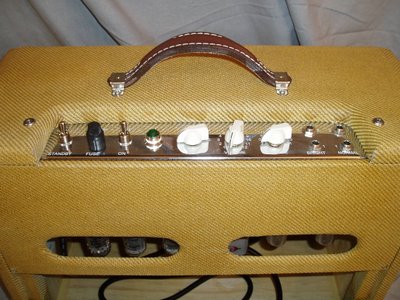

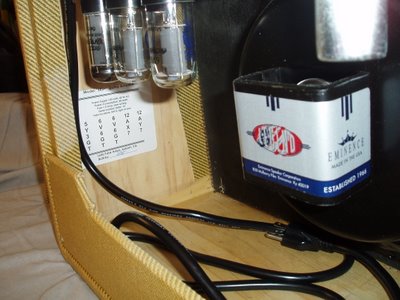
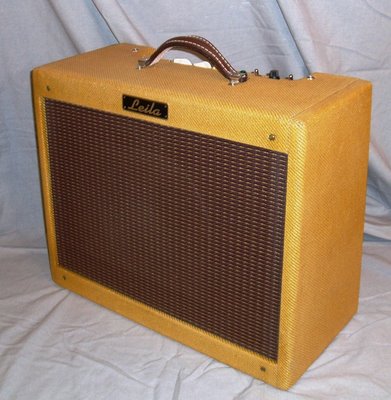 Overall a great low-mid power amp.
Overall a great low-mid power amp.Leila Custom 5E3-NY Tweed Deluxe
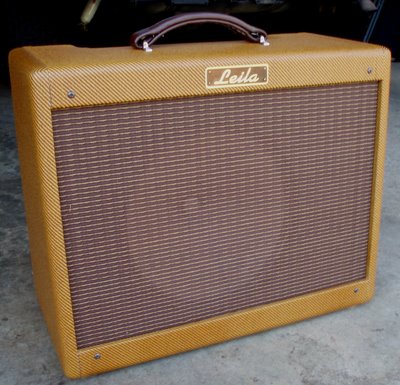 The Leila Custom 5E3-NY Tweed Deluxe. Based on a late 50's narrow panel Fender Deluxe 5E3. The stock circuit uses 1 12AY7 preamp tube, 1 12AX7 phase inverter tube, 2 6V6 power tubes, 1 5Y3 rectifier tube and 1 12" alnico speaker to produce about 15-18 watts of power. Controls include on/off toggle, standby toggle in place of the old ground switch, 2 channels with a volume control for each and 1 tone control.
The Leila Custom 5E3-NY Tweed Deluxe. Based on a late 50's narrow panel Fender Deluxe 5E3. The stock circuit uses 1 12AY7 preamp tube, 1 12AX7 phase inverter tube, 2 6V6 power tubes, 1 5Y3 rectifier tube and 1 12" alnico speaker to produce about 15-18 watts of power. Controls include on/off toggle, standby toggle in place of the old ground switch, 2 channels with a volume control for each and 1 tone control. I was contacted by a university professor on the east coast who was looking to capture Neil Young's tone. I beefed up the power rail to allow the use of 6L6 power tubes and upgraded the transformers. Tube compliment now includes 1 NOS GE 12AY7, 1 Electro-Harmonix 12AX7, 2 JJ 6L6's, and 1 JJ GZ34.
I was contacted by a university professor on the east coast who was looking to capture Neil Young's tone. I beefed up the power rail to allow the use of 6L6 power tubes and upgraded the transformers. Tube compliment now includes 1 NOS GE 12AY7, 1 Electro-Harmonix 12AX7, 2 JJ 6L6's, and 1 JJ GZ34.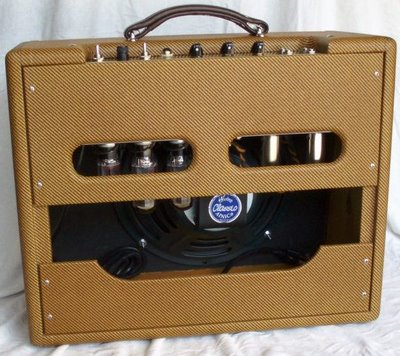
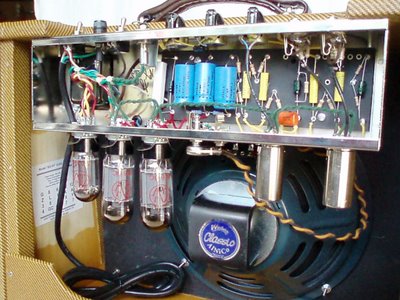 Here is what the customer had to say about the amp:
Here is what the customer had to say about the amp:
Leila 5F2A Custom Tweed Princeton
The correspondence I've had from the customer has been great. He has been using the amp a lot and just loves it. Here are some comments from him:
"I am so happy with how it sounds. I have obviously only had a chance to play it alone in my house (making my wife wince with the volume), but it is sounding exactly how I'd hoped. I am particularly impressed with the variation that you get between the two inputs - I am thinking of experimenting with an a/b switch that I have, running a channel into each input and switching them that way. "
"The pull-boost feature is awesome too. With that thing pulled the amp can become a real fire-breather real fast! Just the kind of tone / size / everything that I was hoping for. When I get the chance to gig with it a little bit I'll drop you another update.
Again, I am really really happy with it, Morgan. Thanks again for all the time and effort that you put into building this for me."
Leila 5F1 Cutom Tweed Champ
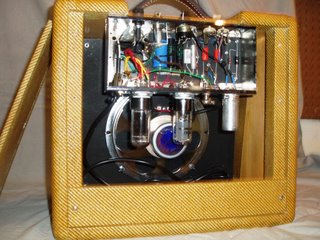



Monday, November 06, 2006
Leila Vintage Electronics
Since I wasn't about to buy a whole new amp for playing around the house, I decided that I would fix the little guy. After a few weeks of research, I ordered the parts, bought a soldering iron and quickly was the proud owner of a perfectly working vintage tube amp. I could not believe how much better the amp sounded after I overhauled it. It had become easily the best sounding amp that I ever owned.
I had to do more!
I began to buy broken amps off of eBay, fix them up and resell them. Among those were a 1959 Gibson GA-5T,
a 1958 Silvertone 1433,
a couple of Fender Musicmaster Bass amps,
a Valco made Gretsh,
and a few more that I never photographed.
I then finally built my own amp from scratch. Once I did that, I found it very difficult to go back to cleaning out 50 year-old dust bunnies from vintage amps.
